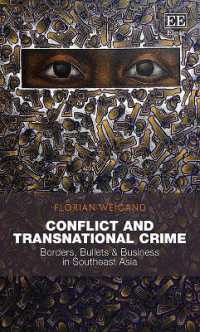Full Description
The SARS-CoV-2 pandemic has had an undeniable impact on cybercrime. The initial crisis quickly became a global catastrophe with multiple consequences in economics, health, and political and social fields. This book explores how this global emergency has influenced cybercrime. Indeed, since feeding off new vulnerabilities, thanks to the effects of the pandemic crisis in various states around the world, cybercrime has increased and evolved.
In 2020, the world was already dealing with numerous tensions and the effects of the global crisis have therefore only tended to exacerbate the issues that relate to cybercrime. For example, radicalization and identity theft has found an environment in which they thrive: the Internet. Criminals have been able to adapt their modus operandi, their targets and their attack vectors. However, on the plus side, the response of law enforcement and public authorities, in terms of the legal, policing and policy side of cybercrime, has also been adapted in order to better combat the increase in this phenomenon.
Contents
Introduction ix
Daniel VENTRE and Hugo LOISEAU
Chapter 1 The Evolution of Cybercrime During the Covid-19 Crisis 1
Daniel VENTRE
1.1 Introduction 1
1.2 Observing the evolution of cybercrime 4
1.2.1 Leveraging annual data: the case of India 8
1.2.2 Leveraging monthly data 11
1.2.3 Leveraging weekly data: the case of China 21
1.3 Has the global geography of cyberattacks changed? 29
1.4 Conclusion 34
1.5 Appendix 39
1.5.1 Cybercrime tools: malware 39
1.5.2 CVSS as indicators of vulnerability levels 40
1.5.3 Heterogeneity and complexity of cybercrime typologies 41
1.5.4 Attitude of companies toward cyber risks: the case of the United Kingdom 46
1.6 References 47
Chapter 2 The SARS-CoV-2 Pandemic Crisis and the Evolution of Cybercrime in the United States and Canada 49
Hugo LOISEAU
2.1 Introduction 49
2.2 The impacts of the SARS-CoV-2 pandemic 50
2.3 Cybercrime and SARS-CoV-2 52
2.3.1 Targets and victims 53
2.3.2 Malicious actors 57
2.3.3 Cyberspace: a propitious environment for cybercrime 58
2.4. The evolution of cybercrime in North America during the pandemic 61
2.4.1 The United States 62
2.4.2 Canada 67
2.5 Discussion 69
2.6 Conclusion 72
2.7 Acknowledgments 74
2.8 References 74
Chapter 3 Online Radicalization as Cybercrime: American Militancy During Covid-19 81
Joseph FITSANAKIS and Alexa MCMICHAEL
3.1 Introduction 81
3.2 A new typology of cybercrime 83
3.3 Internet connectivity and violent militancy 85
3.4 The pre-pandemic domestic threat landscape 87
3.5 The domestic threat landscape of the pandemic 88
3.6 Pandemic accelerationism 91
3.7 From virtual to real-life criminality 93
3.8 Online radicalization during Covid-19 94
3.9 A new methodological paradigm for online radicalization? 98
3.10 Conclusion: meta-radicalization as cybercrime 100
3.11 References 102
Chapter 4 Cybercrime in Brazil After the Covid-19 Global Crisis: An Assessment of the Policies Concerning International Cooperation for Investigations and Prosecutions 109
Alexandre VERONESE and Bruno CALABRICH
4.1 Introduction: Brazilian cybercrime and the Covid crisis impact 109
4.2 Cybercrime in the literature and the Brazilian case 112
4.3 A theoretical model for international cooperation 115
4.4 The evolution of cybercrime in Brazil 119
4.5 The evolution of the Brazilian legal system concerning cybercrime and its connection to the international regime 126
4.6 Managing international cooperation without having the best tools 133
4.7 Difficulties with cooperation: joints, mortises, and notches 137
4.8 Conclusion: what to expect from the future? 140
4.9 References 142
4.10 Appendix: List of interviews and questions 147
Chapter 5 Has Covid-19 Changed Fear and Victimization of Online Identity Theft in Portugal? 149
Inês GUEDES, Joana MARTINS, Samuel MOREIRA and Carla CARDOSO
5.1 Introduction 149
5.2 The impact of the Covid-19 pandemic on cybercrime 150
5.3 Evolution of cybercrime in Portugal 153
5.4 Online identity theft (OIT) 155
5.4.1 Definition and modus operandi 155
5.4.2 RAT applied to cyberspace 156
5.4.3 Individual variables and OIT victimization 159
5.5 Fear of (online) crime 160
5.5.1 Determinants of fear of (online) crime 160
5.6 The present study 162
5.6.1 Measures 163
5.6.2 Results 165
5.6.3 Variables associated with online victimization and fear of identity theft 169
5.7 Conclusion 170
5.8 References 171
Chapter 6 A South African Perspective on Cybercrime During the Pandemic 177
Brett VAN NIEKERK, Trishana RAMLUCKAN and Anna COLLARD
6.1 Introduction 177
6.1.1 Background to South Africa and the pandemic 178
6.1.2 Methodology 179
6.2 International rankings 180
6.3 Cybercrime and related legislation 183
6.4 Cybersecurity incidents 186
6.4.1 Ransomware 186
6.4.2 Scams and fraud 188
6.4.3 System intrusions and data breaches 190
6.4.4 Disinformation and malicious communications 192
6.4.5 Other 196
6.5 Discussion 197
6.6 Conclusion 199
6.7 References 199
List of Authors 211
Index 213






